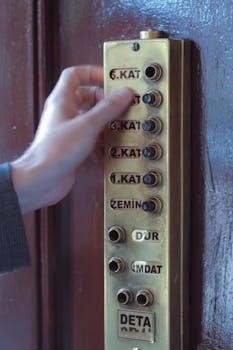Many Bad Boy mower owners experience challenges with their deck lift mechanisms․ This can include difficulties raising or lowering the mower deck․ These issues can stem from various mechanical problems, requiring troubleshooting․
Common Problems with Bad Boy Mower Decks
Bad Boy mower decks can suffer from several common issues that impact their performance․ One frequent problem is the inability of the deck to engage properly, or the blades failing to start․ Additionally, many users report problems with raising or lowering the deck, which can be frustrating․ Inconsistent cutting performance is another common complaint, leading to uneven lawns․ These issues may not always be due to electrical or mechanical failures; sometimes, the deck may require leveling or cleaning․ Addressing these common problems promptly is important for maintaining the mower’s efficiency and ensuring a quality cut․

Electric Deck Lift Malfunctions
Electric deck lifts on Bad Boy mowers can experience malfunctions, often preventing the deck from raising or lowering correctly․ These issues may stem from various electrical components or mechanical parts․
Actuator Failure and Moisture Issues
A common cause of electric deck lift problems in Bad Boy mowers is actuator failure․ This often manifests as the deck not moving up or down correctly․ The actuator’s internal components might fail due to wear or damage․ Moisture intrusion into the actuator housing can also cause significant problems․ When moisture is present, it can corrode the internal mechanisms and prevent the actuator shaft from screwing in or out properly․ This disruption in movement can lead to the deck being stuck or operating erratically․ Checking for moisture and ensuring the housing is well sealed can help mitigate these issues․
Screw Shaft Problems and Rust
Another significant issue affecting the electric deck lift is problems with the screw shaft․ The screw shaft, responsible for the raising and lowering motion, can become problematic due to rust․ Over time, the screw shaft sleeve can become excessively rusty․ This corrosion hinders the smooth movement of the actuator and prevents the deck from operating correctly․ If the shaft cannot screw in and out properly, the deck will not raise or lower correctly, despite the actuator spinning․ Addressing rust by cleaning and lubricating the shaft is crucial to maintain the proper operation of the deck lift system․

Troubleshooting Deck Lift Problems
When encountering deck lift issues, a systematic approach is needed․ Start by examining the actuator and its housing for any signs of moisture or damage․
Checking the Actuator Housing
When troubleshooting an electric deck lift, the actuator housing is a crucial starting point․ Begin by carefully unscrewing the actuator to access the housing․ Examine the interior for any signs of moisture, which can hinder the actuator’s performance․ Ensure that the housing is properly sealed; a compromised seal may allow moisture to enter, leading to malfunctions․ Check for any visible damage to the housing itself, such as cracks or breaks․ If moisture is present, consider applying a sealant gasket to prevent further issues․ Proper sealing of the actuator housing is vital for the smooth operation of the deck lift․
Addressing Rusty Screw Shaft Sleeves
If the screw shaft sleeve appears rusty, this can also cause problems with the electric deck lift․ Rust can prevent the shaft from smoothly screwing in and out, impeding the deck’s movement․ Start by thoroughly cleaning the rusty sleeve to remove the corrosion․ Use a wire brush or similar tool to scrape away the rust and debris․ Once clean, apply a generous amount of grease to the sleeve․ This lubrication should help the shaft move more freely․ If cleaning and greasing do not resolve the issue, consider replacing the sleeve to ensure proper deck lift functionality․
Mechanical Deck Lift Issues
Mechanical problems within the deck lift system can also cause malfunctions․ These issues often involve the physical components like links and springs that assist the deck’s movement․
Faulty Deck Lift Links and Springs
The mechanical deck lift system relies heavily on the integrity of its links and springs․ Faulty or worn-out lift links can prevent the deck from raising or lowering smoothly, or even at all․ Similarly, weakened or broken lift springs can fail to provide the necessary tension for the mechanism to operate correctly, resulting in inconsistent deck height․ Regular inspection of these components is crucial․ Replacing damaged or worn-out links and springs is often necessary to restore proper deck lift functionality, ensuring smooth and consistent operation of the mower deck while cutting grass․ This can address the issue of uneven cuts due to improper deck height․

Other Related Issues
Beyond the deck lift itself, other issues can impact mower performance․ Transaxle and hydraulic system problems, along with steering and tire pressure, may indirectly affect deck operation․
Transaxle and Hydraulic System Problems
The transaxle, crucial for transferring power to the wheels, can experience issues affecting the mower’s overall performance, and indirectly impacting the deck lift․ Hydraulic fluid leaks or a malfunctioning charge pump within the system can cause problems․ Leaks require a new seal kit, while a defective hydro system may necessitate professional repair․ These issues can lead to a rougher ride and poor cut quality, especially on sensitive grasses․ Proper maintenance of the transaxle and hydraulic system is crucial for maintaining a smooth operation and an effective mowing performance․ Ignoring these issues can lead to more severe complications․
Steering Problems and Uneven Tire Pressure
Steering issues, often manifesting as the mower pulling to one side, can indirectly impact the deck’s performance․ Uneven tire pressure is a common culprit, causing the mower to veer off track and become difficult to control․ Ensuring all tires are inflated evenly to the recommended PSI is essential for stable operation․ Additionally, underlying hydraulic or transaxle issues can contribute to steering problems․ Addressing tire pressure and investigating potential transaxle problems are crucial steps in resolving steering issues, which can affect the overall mowing experience․ Regular maintenance of the steering system will help prevent problems․
Additional Common Problems
Beyond deck lift issues, Bad Boy mowers can experience shaking, belt problems, and spindle imbalance․ These issues affect cut quality and can indicate the need for maintenance․
Deck Shaking and Belt Issues
A common concern with Bad Boy mowers is deck shaking, often noticed after prolonged use․ This can result from a loose belt at the drive pulley’s rear․ Missing or loose screws on pulleys or lock collars can contribute․ A worn spindle key may also be the cause of deck shaking․ Addressing this often involves tightening the belt tension, ensuring all screws are present and secure, and checking for worn components․ Replacing worn parts like the spindle or bearings can resolve the issue if needed․ It’s crucial to identify if the problem is belt related or if further investigation into blade balance is needed․
Spindle and Blade Imbalance
If deck shaking persists after addressing belt issues, spindle and blade imbalance should be investigated․ An unbalanced blade or a damaged spindle can cause significant vibration during operation․ Checking for any wear or damage on the spindles and ensuring blades are properly balanced is crucial․ If blades are not balanced, they should be either rebalanced or replaced․ Similarly, worn or damaged spindles should be replaced․ These steps are vital to reduce vibrations and ensure smooth, consistent cuts․ If issues persist, professional assistance might be required to diagnose and fix the problem․

Importance of Proper Maintenance
Regular maintenance is crucial for preventing deck lift issues․ Consistent checks and cleaning can help avoid many common problems․ Preventative measures ensure a longer lifespan for the mower․
Regular Checks and Cleaning
Implementing a routine of regular checks and cleaning is essential for the longevity and optimal performance of your Bad Boy mower’s deck lift system․ Begin by visually inspecting all components for any signs of wear, damage, or loose connections․ Pay close attention to the actuator housing, looking for any moisture or corrosion․ Clean the screw shaft and sleeve, removing any accumulated dirt, debris, or rust that could impede smooth operation․ Lubricate the moving parts to reduce friction and prevent further corrosion․ This proactive approach will help identify potential issues early, preventing more serious problems and costly repairs down the line․ Consistent maintenance ensures a reliable and effective deck lift system․
Preventative Measures for Deck Lift Systems
To ensure the long-term reliability of your Bad Boy mower’s deck lift system, implementing preventative measures is crucial․ Shield the actuator and other electrical components from moisture to prevent corrosion and malfunction․ Regularly lubricate the screw shaft and sleeve to reduce friction and wear, ensuring smooth movement․ Always store the mower in a dry environment to avoid rust formation․ Avoid forcing the deck lift mechanism beyond its designed range, which can cause damage․ Periodically check and tighten all bolts and connections․ Following these simple steps will significantly reduce the likelihood of deck lift problems and extend the life of the system․
